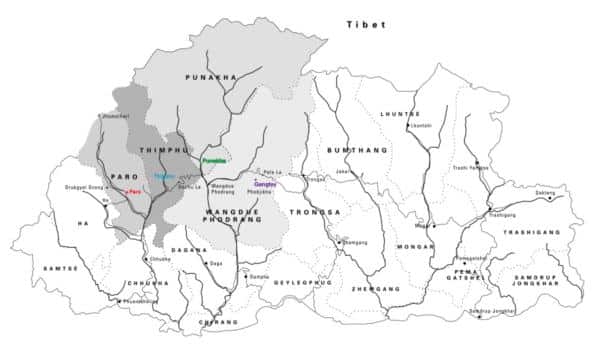Kingdom & Religion

Introduction:
OR CALL THE BHUTAN TRAVEL EXPERTS ON
AUS toll free, James – 0412 416 111, Nicola – 0413 598 669
Geography
The Kingdom of Bhutan, almost exactly the same size as Switzerland, lies east of the Indian state of Sikkim and west of the Indian state of Arunachal Pradesh. It is south of Tibetan region of China and north of the Indian states of Assam and West Bengal.
Located in the heart of the eastern Himalayan mountain range, Bhutan is a land-locked country surrounded by mountains in the north and west. However its deep valleys running south from the Himalayas offer a remarkably temperate climate, even in winter when compared to northern Europe or northern USA, and a visit can be made any time of the year.
Altitudes in the far south range from 300 to 1370 metres and in the more populated central region range from 120 metres in the east around Trashigang to a high of 5190 metres over the highest pass.The altitude at Paro airport is approx 2235 metres and in the capital Thimphu 2347 metres.

King & Government
The current 5th King of Bhutan is King Jigme Khesar Namgyel Wangchuck who was crowned on 09 December, 2006 and, along with his wife Queen Pema, remains very close to all the citizens of Bhutan who hold their monarchy with deep respect. Few nations can boast to a dynasty of 5 Kings who have all shown great courage, vision, wisdom and compassion.
The 4th King made the monumental and far-sighted decision to convert Bhutan to a full democracy, forming a Parliament, and paving the way for free and fair democratic elections in 2006. The current Prime Minister is Lyoenchhen Lotay Tshering who was elected in 2018 and is forged with the task of handling Bhutan’s many challenges as it continues to rapidly modernize.
Religion in Bhutan
The Buddhist faith plays a fundamental role in the cultural, ethical and sociological development of Bhutan and its people. It permeates all strands of secular life, bringing with it a reverence for the land and its well being. Annual festivals are held in each district, which are important spiritual occasions.
Bhutan is perhaps the only country in the world to retain the Tantric form of Mahayana Buddhism as its official religion. To ensure the perpetuation of Buddhism in the Kingdom, one son from each family normally attends monastic school, although this has become less popular over the last 10 years.
The Dzongs are both centres of administrative and government activities for an entire valley and they are also predominantly the homes and temples of the monastic community.
